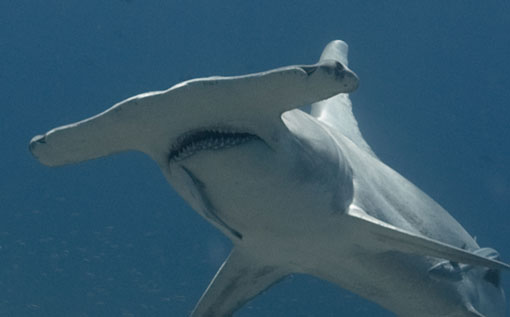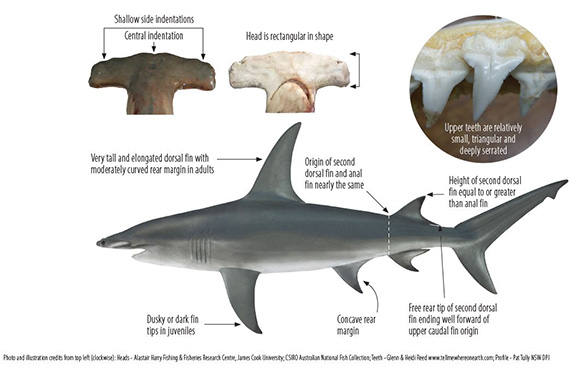
Great Hammerhead Shark

Scientific name
Sphyrna mokarran
Status in NSW
Vulnerable.
Characteristics
Similar to all members of the hammerhead family, the Great Hammerhead Shark has a large flattened 'hammer like' head with wide set eyes. The Great Hammerhead Shark can be distinguished by their large size; very tall and distinctly sickle shaped first dorsal fin; large second dorsal fin; relatively straight frontal margin of their hammer-shaped head; strongly concave rear edge of their pelvic fins; and their clearly serrated teeth. Great Hammerheads have a wide thick head with eyes at the margins of the hammer which is almost rectangular in shape. The species also has a tapered body which is bronze-pale brown on the dorsal surfaces and pale on the ventral surfaces.
Size
The Great Hammerhead Shark is the largest species of hammerhead in the world. Females give birth to live young that are approximately 65 cm long. Adults can grow to 6 m in length however they are only rarely observed over 4.5 m.
Species similar in appearance
It is often confused with other species of hammerhead shark including the Smooth Hammerhead and the Scalloped Hammerhead Sharks.
Distribution
The Great Hammerhead Shark has a circumglobal distribution in tropical and warm temperate seas from latitudes 40° N to 35° S, however the species has been recorded as far south as Sydney (34°).
Habitat
The Great Hammerhead Shark is a coastal-pelagic and semi-oceanic species, occurring along coastlines, continental shelves and adjacent drop-offs to about 80 m depth. The species is typically nomadic in its movements compared to other hammerheads, and migrates to cooler waters in the summer months.
Why is the Great Hammerhead Shark threatened?
- Commercial, recreational and shark meshing bather protection fisheries are the primary threat to the Great Hammerhead Shark;
- Great Hammerheads are generally regarded as being a solitary animal, and are unlikely to be abundant wherever they occur;
- Quantifying historical trends in mortality of Great Hammerheads across commercial, recreational and bather protection fisheries is difficult as most hammerhead landings have not been identified to species level due to difficulties with species identification;
- Great Hammerheads have low fecundity as a result of relatively slow growth rates, late onset of sexual maturity and a biennial reproductive cycle; reducing the species recovery potential;
- As a migratory species, Great Hammerheads are subject to fishing pressure in a range of jurisdictions and are targeted for their large, high value fins in some jurisdictions.
More information
- Fisheries Scientific Committee - Final determination (November 2011) (PDF, 110.21 KB)
- Hammerhead Sharks in NSW – A guide for fishers
- Hammerhead Sharks in NSW – Frequently Asked Questions
- Infographic- Identification guide for Hammerhead Sharks in NSW
- Primefact: Great Hammerhead Shark (Sphyrna mokarran)
- Priorities Action Statement - Actions for Great Hammerhead Shark


